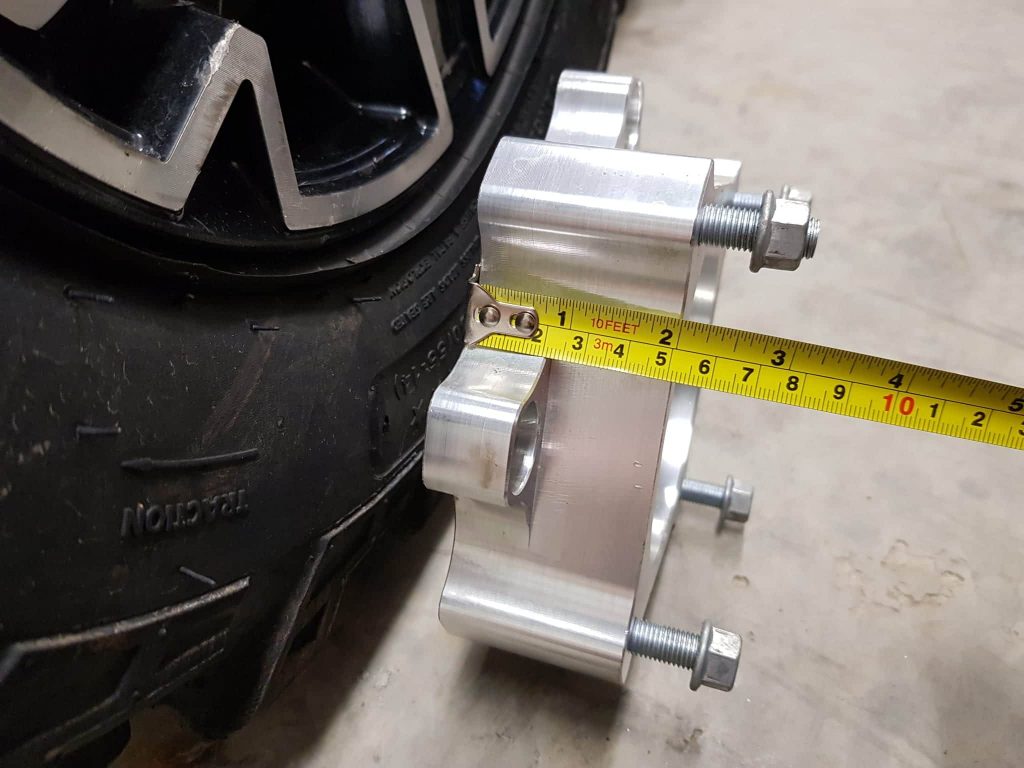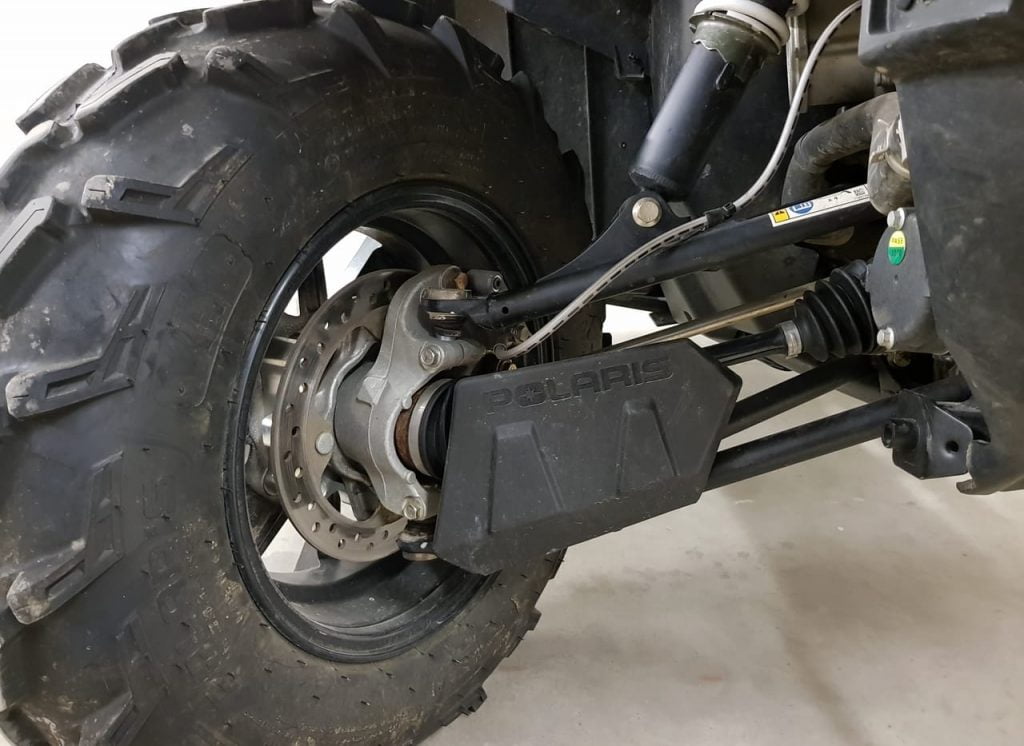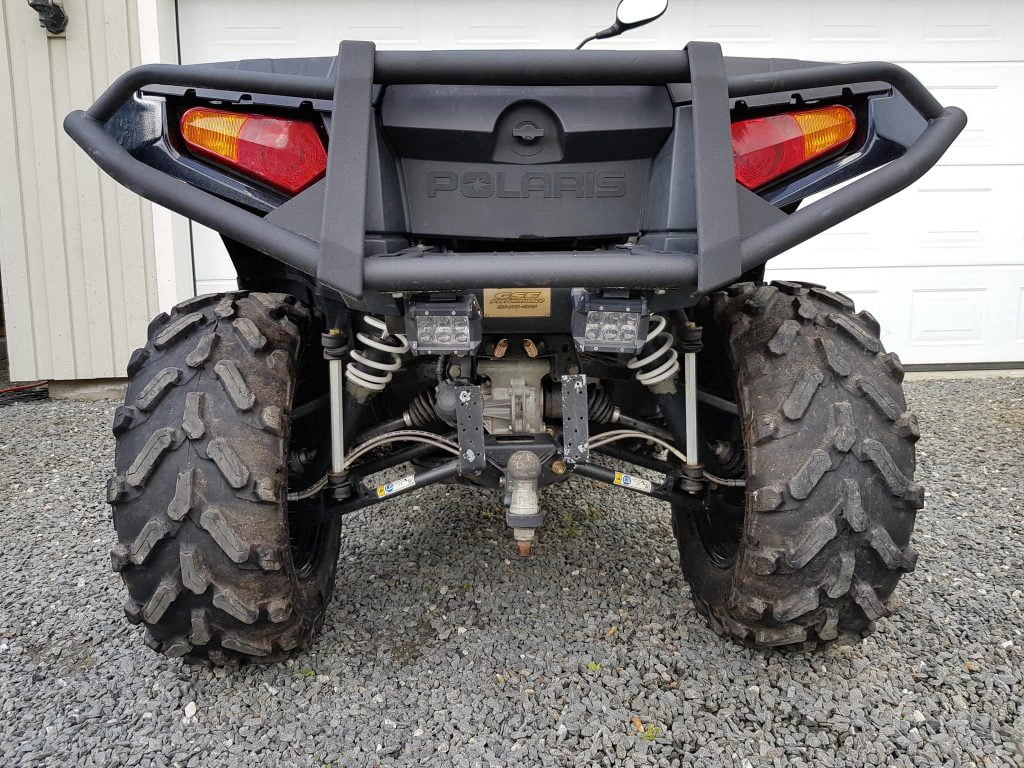The use of wheel spacers on an ATV is a subject with as many opinions as there are riders. There are numerous pros and cons. Spacers can be beneficial in some aspects, while in others, they can be detrimental.
A few years ago, when searching for a set of spacers for my Polaris Sportsman, I found the myriad of often contradicting information on the subject quite overwhelming.
To assist potential wheel spacer buyers in making an informed decision, I’ve consolidated all the possible pros and cons, as well as guidelines on when to use and when not to use them. Additionally, I’ve included some lessons from my own experience with them.
What Are Wheel Spacers?
Wheel spacers are metal discs (usually aluminum or steel) that fit between the wheel hub and the wheel. They push your wheels outward to increase your ATV’s overall width without replacing wheels or suspension parts.
Spacers come in various thicknesses—typically 1” to 2.5”—and can be either bolt-on or slip-on, depending on design.

Let’s look at various riding scenarios where you may need or benefit from having wheel spacers installed.
If you’ve already decided you need spacers, this is how to install them.
| Pros | Cons |
|---|---|
| Increased stability on rough terrain | Adds stress to bearings and suspension parts |
| Better clearance for chains/tire rub | Can change steering geometry (e.g., bump steer) |
| Improved appearance/aggressiveness | May void warranties or cause inspection issues |
| Affordable compared to new rims | May require frequent torque checks and maintenance |
| Easy DIY install | Lower-quality spacers can fail |
Pros of ATV Wheel Spacers
Better Clearance for Installing Tire Chains
Clearance issues when installing tire chains are a common reason for having to get wheel spacers. It was the main reason I had to get a set for my Polaris.
Most ATVs are not made to be used with tire chains. So when you install them, you may run into issues where the chains catch onto and damage various components of the ATV.
The front wheels are usually the most affected because they turn. Brake lines, inner fenders, or suspension parts may conflict with the chains.
You usually have more space at the rear wheels, and because they do not turn, you may apply the rule of thumb that says any clearance is proper clearance. But even at the rear, you may find the chains hitting your exhaust muffler or other components close to the wheel.
Adding a set of spacers should give you the clearance you need. You will likely need 1 to 2 inches thick spacers. I got the two-inch size for my Polaris, but 1,5 inches would probably be a better solution for this particular bike.
The best way to find out what size spacers you need is to install the chains with your stock wheels and measure how much clearance you’ll need. There is no exact science to this, but I recommend you aim for about one inch of clearance around the tire.
Better Stability on Steep Slopes or Rough Terrain
After the winter, I left my two-inch wheel spacers on the ATV just for fun (or rather out of laziness).
We often ride in areas with steep slopes. One plausible mishap when ascending such a hill is hitting a root, a bump, or a rock, causing the ATV to flip to one side and end up positioned sideways on the hill.
Without wheel spacers, it won’t be long until it flips and starts rolling down the hill. This happened to me, and for a second, I was sure that the ATV would start rolling.
But then I remembered I still had my wheel spacers, which ultimately saved me.
Another benefit is when you are doing some low-speed technical riding in really bumpy terrain. I do much of that too, and the increased stability (not so tippy) is quite noticeable.
With improved stability, you might find yourself tackling even bigger challenges, but I would advise against it.
So, to sum things up: a wider wheel stance will provide increased lateral stability when riding in hilly terrain, which might be beneficial in some of the more extreme riding situations.
Better Stability on Paved Roads
Where I live, you can legally use an ATV on public roads.
But when you ride at high speeds on paved roads, there is a risk that the ATV may flip due to the combination of excellent traction and narrow track width.
After installing spacers, I noticed that the ATV felt much more stable when riding turns.
The difference is not so noticeable when riding on gravel roads or trails. That’s because the lesser traction allows the ATV to slide sideways instead of flipping.
Most ATVs are designed to handle sharp turns on gravel roads without needing spacers to be stable. But it felt like they helped keep the ride steady on paved roads.
Increased Clearance When Installing Bigger Tires
When installing bigger and wider tires on your ATV, you may encounter many of the same rubbing issues when installing tire chains.
One way to solve this is by getting new rims with a different offset. But if you plan on using your old rims, you may need to add a set of spacers to prevent your new wheels from hitting various bike components.
It’s Cheaper Than Getting a Set of New Rimes
As mentioned above, getting a set of new rims with a different offset is one way to solve your problem when you run into clearance issues. Quality wheel spacers are not cheap but will still set you back less than most rims on the market.
Increased Safety
It is not hard to argue that better stability generally equals a safer ride. However, Spacers make the bike harder to turn, so it’s not all good. More on that later.
It Makes the ATV Look Better
The last one of the Pros comes down to personal preference. Some riders prefer the bike’s more aggressive look when widening the wheel stance.
Cons of ATV Wheel Spacers
There are a lot of benefits to installing wheel spacers on an ATV, but there are quite a few potential downsides as well. Ultimately you must decide whether you can accept some of the cons listed below.
You can minimalize most of them by choosing spacers that are only as thick as necessary but no more. Less is more when it comes to wheel spacers.
Increased Wear on Drivetrain and Suspension
Moving the tires further out from the axles will increase the strain on wheel bearings, ball joints, axles, and just about any component of the bike’s drivetrain and suspension.
The further you offset the wheels, the more significant momentum you get. This applies to both wheel spacers and different offset rims.
Therefore, it’s crucial to choose spacers that provide the extra clearance you need and no more. There are no added benefits to widening the bike beyond necessity, but the drawbacks will start to appear one by one.
The ATV Become Harder to Steer
The difference in steering geometry between stock and two-inch spacers is quite noticeable. Even bikes that have power steering may struggle to turn the wheels from time to time.
The reason why this happens is quite simple. When riding stock, the wheel’s center is aligned with the pivot point in the ball joints. When you turn, the wheel also pivots (rotate).
However, when you add spacers, you’re not just rotating the wheel but also moving it back and forth. Essentially, you’re forcing it to swing.
This extra movement puts much strain on the power steering system, which may cause premature wear or damage if you don’t pay attention. A bike without power steering will get heavier steering which may cause fatigue for the rider.
Increased Bump Steer (Bar Whip)
Bump steer is the twitch in the handlebar when you hit a rock or a small bump. Due to the same steering geometry changes described above, these twitches will become noticeably more powerful when you install spacers.
This adds to the strain on the power steering or the rider in a non-power steering ATV.
Expert Tip: Using wheel spacers only at the rear wheels will add a lot to stability without the downsides of changing the front wheels’ steering geometry.
The ATV May Become Too Wide for Some Trails
With a wider stance, your ATV may not fit as well into the ruts on muddy trails where others ride with stock configurations. Your wheels will brush off on track edges and rocks where others pass through. It will become harder to ride, and you risk damaging your wheels.
Some trails are set with a maximum legal width of 50 inches. Adding wheel spacers may make your ATV illegal to use on such trails.
ATV May No Longer Fit Between Trees or Through Narrow Passages
The extra width may be enough so you don’t fit between when riding in dense forests, through narrow gates, or between narrow rock passes.
They Will Likely Make You Dirty
When installing wheel spacers, your stock fenders may no longer protect you from flying mud and dirt.
Stock wheels on most ATVs are about in-line with the fenders. When you install wheel spacers, you will quickly learn that this design feature did not happen accidentally.
Expect to get dirty or pay for a set of fender-flares that widens your fenders and increases their coverage.
The ATV Will No Longer Fit All Truck Beds and Trailers
Ensure your trailer or truck bed is wide enough for a wider ATV. This aspect is sometimes overlooked when people install wheel spacers. Measure twice, buy once!
Alternatives to Wheel Spacers
If you’re not sold on using wheel spacers—or want a more permanent solution—there are a few alternatives worth considering. These options tend to offer better long-term durability and maintain proper suspension geometry, though they may cost more upfront.
Offset Wheels
Offset wheels achieve the same wider stance as spacers, but do it by moving the mounting surface inward. They reduce stress on suspension components compared to spacers and are often a safer, more robust solution, especially for aggressive riders or heavy-duty use.
Wider A-Arms or Axles
Upgrading to wider A-arms or extended axles increases your ATV’s width while keeping the steering geometry intact. This is the best option for serious trail riders or racers seeking high performance and stability, though it typically requires more mechanical work and a higher investment.
Longer Wheel Studs
For riders who need just a little extra clearance—such as avoiding light tire rub—longer wheel studs combined with slightly offset wheels can do the trick. It’s a subtle change, but it avoids the downsides of adding leverage to the wheel hub like spacers do.
Final Tips for Using Wheel Spacers Safely
- Use high-quality spacers (e.g., billet aluminum from reputable brands)
- Torque properly and use a torque wrench every ride or after heavy use
- Avoid stacking spacers—this compounds leverage and risk
- Don’t overtighten—you can strip threads or warp the spacer
Related Questions
Are ATV wheel spacers safe?
Good-quality ATV wheel spacers are perfectly safe to use if installed correctly. Make sure you use quality lug bolts or studs as well. Do not use wider spacers than necessary, as they affect suspension and steering geometry. Inspect them regularly to check for damage.
Are ATV wheel spacers worth it?
Wheels spacers are worth it when widening the ATV to fit tire chains or larger wheels. However, they come with a few downsides, such as heavier steering and increased wear on the ATV. Some riders feel that the disadvantages outweigh the benefit of improved stability.
The Bottom Line
ATV wheel spacers can be a game changer, giving your ride more stability and better clearance. But they’re not a one-size-fits-all fix, as they can also make steering heavier and cause more wear on your ATV. Ultimately, whether they’re worth it depends on your unique needs and the terrain you’re tackling.




